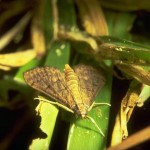Sod webworm caterpillars, like armyworms and cutworms, also feed at night. During the day, they burrow into the thatch or soil. Young larvae skeletonize blades of grass. Older larvae cut off grass completely and form tunnels of silk in the grass. Winds of adult moths are “rolled up” over the abdomen when at rest.
The tropical sod webworm has been particularly damaging in recent years to turfgrass in the upper coastal region of Texas. Caterpillars of this species are translucent cream or greenish with dark spots. Wings of adult moths “held out” (like jet fighter-plane wings) when at rest (see figure).
In July 2010, Michael E. Merchant, reported injury to turfgrass in a common bermudagrass lawnlawn in Collin Co., McKinney, TX. The surface of the dead areas was covered with fluffy “frass” and silken sheets of webbing. After dumping disclosing solution (soapy water) on the ground numerous large (35‑45 mm) caterpillars emerged. David J. Shetlar, of The Ohio State University, identified them as burrowing webworms, Acrolophus spp. (Acrolophidae), stating that “the larvae are characterized by having the heavily sclerotized pronotum and a velvet‑like cuticle for the rest of the body, no rows of sclerotized plates on the thoracic and abdominal segments. The crochets should be biordinal in the Crambidae and multiserial in the Tineoidea, which includes the Acrolophidae.”
Description
Adult tropical sod webworm moths are dingy brown with wing spans of about 3/4 inch. Wings are held flat over the back when at rest, giving the insect a triangular appearance. Caterpillars grow to almost 3/4 inch long , appearing translucent green with small dark-colored spots or plates arranged on each body segment and a dark, yellowish-brown head capsule.
Several other species of sod webworms occur in Texas, mainly from the genus, Crambus. These sod webworms can be distinguished in the adult stage by the way the moths roll their wings around their bodies when at rest rather than holding them out. Larvae are distinguished by the different patterns of plates (panicula) on their thoracic segments. Other common plant-feeding pyralid moths include the genista caterpillar, Uresiphita reversalis (Guenee) (See also the fall webworm) and the lesser canna leafroller, Geshna cannalis (Quaintanaca) (See canna leafroller).
Life Cycle
Females lay creamy white eggs in clusters of up to 15 eggs on grass blades, stems and turf debris. Tiny 1/32 inch long caterpillars hatch from eggs in 6 to 10 days and develop through 7 or 8 stages (instars) over 25 to 50 days, depending upon temperature. Larvae form a 3/8 inch long reddish-brown pupa in the thatch, sometimes within a shapeless bag spun by the caterpillar. Development from egg to adult occurs in about 6 weeks. Several generations occur during the year, but those occurring in the fall are larger, overlapping and potentially more damaging to turfgrass. This species only survives in areas with mild winters that allow all stages to continue to develop.
Habitat, Food Source
Caterpillars have chewing mouthparts. Adults have siphoning mouths. Caterpillars feed during the night on turfgrasses, including Bermudagrass, St. Augustinegrass, centipedegrass, Bahiagrass, and zoysiagrass.
Damage
Injured grass blades initially appear notched and ragged as tissues are removed from the edges until the entire leaf is consumed. Injured turf is usually spotty within a lawn, but damaged areas enlarge as caterpillars migrate in search of more food. Heavily injured turfgrass may die but usually recovers. St. Augustine grass recovers more slowly than bermudagrass. Caterpillars can be forced up out of infested turfgrass by sprinkling a solution of liquid dishwashing detergent in water on the turf. Caterpillars will climb up on grass blades.
Pest Status
Outbreaks occur in turfgrass in Houston, Texas and elsewhere; numerous low-flying moths are usually associated with infestations; moths readily can be collected near lights at night. Sod webworms are medically harmless.


